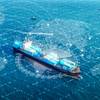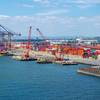Based on half-wave resonance measurements, a quick, accurate means of determining steel thickness can speed ship surveys. It is especially valuable in inspecting old and corroded steelwork. Present-day methods, based on ultrasonic thickness measurements, are not reliable on heavily corroded plates, and for large vessels are also considered too slow.
A new Det Norske Veritas (DNV) system addresses the technological challenge of transmitting 100 percent of the signal energy through corroded steel plates, and receiving and interpreting the reflected signal to give an accurate thickness measurement.
The basic principles of the new measuring method (half-wave resonance) have been known for 40 years. But the application of these principles was not technically feasible until recently, due to a lack of data power and limited transmitter technology. This new method for analyzing acoustic frequency spectra has been developed jointly by DNV and the Norwegian industrial group Kongsberg Defense & Aerospace through an exclusive cooperation agreement.
The measuring method has extreme accuracy in both air and water. The mean strength thickness is processed over a chosen area, providing for further analysis and planning. No removal of scaling and other corrosion products is required. On-line digital registration and processing of inspection data is incorporated and patents have been applied for.
Termed the Resonance Thickness Measurement unit, it has been field tested and mounted on a carrier. The Remote Operated Vehicle (ROV) is lowered into the water to scan the bottom and sides of a vessel up to the waterline. It requires no diver assistance, and will scan 100 percent of the steel thickness over the whole hull area at a speed of one sq. m per second.
The easy-to-operate positioning system gives a navigational accuracy closer than 10mm. The same ROV can be lowered into any water-filled tank for scanning tank internals.
All digital data from the measurements can be fed on-line into the DNV Nauticus SiO product model. Nauticus is a database in which class-related information regarding the hull, equipment and operation is accumulated over a vessel's lifetime. In this application, thickness measurements can be fed into any database for non-DNV classed vessels. Advantages of the new system include:
· Less need for drydocking;
· Reduced inspection time during surveys;
· Greater inspection efficiency; and
· Stripping and cleaning of tanks not required.
The new technology is designed to revolutionize steel-thickness measurements of corroded surfaces.
"If you send down 10 surveyors to measure steel thickness, the traditional ultrasonic way, you will get ten different results," said Per Labom, technical manager of Stena Bulk. "With DNV's new system, we can quickly get reliable measurements in a single operation.'
Sponsored Content
Lower carbon intensity fuels to support your operations

Subscribe for
Maritime Reporter E-News
Maritime Reporter E-News is the maritime industry's largest circulation and most authoritative ENews Service, delivered to your Email five times per week










